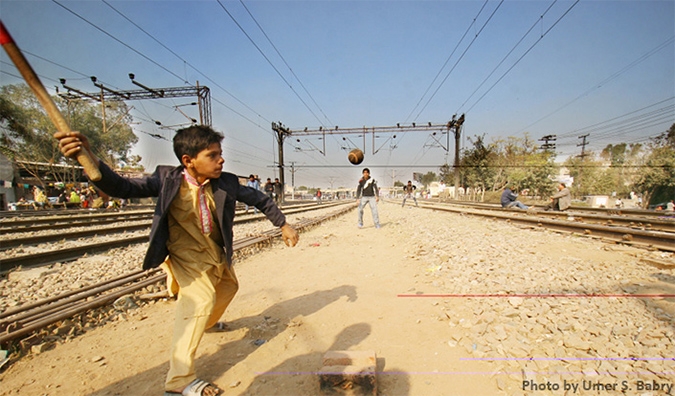I recently had a chance to have a conversation with Javed and Babar Niazi, the Pride of Performance winning vocalists who are the sons of the even more legendary singer Tufail Niazi. Tufail Niazi had the honour of performing the first ever song sung on PTV, when he sang ‘Lai Beqadraan Naal Yaari’. During our conversation, his two sons attempted to explain the lyrics of the song to us.
They said that the message of the song was to warn against beqadray loag (people without a sense of gratitude or values), and tells the tale of unrequited love. But while explaining this song, they gave a very interesting analogy. They said: “Imagine there is a bowler who bowls with all his heart and delivers a great ball. But then the batsman just defends it. So surely the bowler will be crestfallen.” In the analogy, the lover is the bowler who is giving it his all, but the batsman doesn’t value his effort.
Now for a non-Pakistani cricket fan, I wouldn’t expect that analogy to make any sense. Let us repeat the scenario – the bowler has bowled a special ball, and the batsman has played a defensive stroke. Now either the ball was very good, and the batsman was forced to defend; or despite the effort it wasn’t very good, and the batsman was able to defend comfortably. In either case, his disappointment should be linked to how much he was able to master the batsman, his opponent. To be disappointed because the batsman didn’t go for a shot is strange – to view the non-shot as a sign of beqadri is downright perplexing. Why would a bowler want the batsman’s shot to display the same sense of emotion that he did in his ball? Wouldn’t he just prefer bowling well enough to defeat him?
To answer this question is to understand Pakistani cricket, because above anything else, Pakistani cricket is played as an expression of exuberance and passion. If the bowler has bowled his heart out, then the batsman’s correct, or Pakistani, response needs to be an equally passionate shot. If the bowler has submitted himself to the madness, then the batsman must too.

Of course, this is not a direct approximation of how Pakistani cricket is played at the international level. Certainly, many of our batsmen don’t often play with such abandon and our greatest ones – Javed and Hanif – are known for their guile and perseverance respectively. But you see that melodrama and madness quite vividly in our greatest stars, including almost all the famous bowlers (Imran, Wasim, Waqar, Fazal, Saqlain, Qadir, Shoaib, Ajmal, etc) and the most popular batsmen (Afridi and Razzaq are the epitomes, but the likes of Saeed Anwar and Inzamam all had a penchant for belligerence).
"How we play the game, and how we love it, is what becomes a shorthand for our national expression. Yes, we like to win and make records, but it must involve passion"
More importantly, this is how cricket is played by Pakistanis themselves. In streets, in parking lots, in maidaans and Mughal baaghs, under the shadows of mountains and glaciers, off highways and on farmland that has yet to be harvested; on sand, snow, mud and ice, Pakistanis play their cricket as melodramatically as possible. Their feet movement is non-existent, but they will pull their backs going for a big hit. Their frame is tiny, but they will force themselves to bowl thunderbolts. Their catching is pathetic, but they are addicted to attempting direct hits on the stacked pebbles or plastic chair or makeshift steel frame that serves as the wicket. They will burn, drown, tape, scratch and tear various forms of balls to find movement and pace. They will fashion planks, doors, rods and pipes to serves as the bat and discover new grips, holds, trigger movements or strategies that ensure every ball is hit for six. This is how Pakistanis want to play.
There might be many reasons for this approach to the game. Perhaps cricket’s rise (which in terms of relative popularity compared to other sports, can be seen as rising from the late 1970s and exploding after the 1992 World Cup win) coincided at a time when much of Pakistan’s culture – its poems and literature, its theatre and film – were struggling or being oppressed. Cricket thus came to become a replacement for many of these. Perhaps it is because of the oral-narrative culture we are part of, which gives rise to looking at the world through a moral lens and identifying heroes and villains. Perhaps the game has become an expression of an inherent spiritual tendency, marvellously articulated in Osman Samiuddin’s thesis about the Haal that Pakistani cricket displays.
Whatever the reason, there is no denying that cricket is everywhere. It was the setting for one of the first blockbusters of the new Pakistani commercial cinema. Every major event, and some series or tours, becomes a way for a litany of pop bands to release songs focused on it. And with the side’s greatest captain now a politician who is a permanent fixture on the screens, cricketing analogies and expressions have become a shorthand for explaining the political system itself. Even religion, the one area whose authorities have often clashed with cultural practices, has embraced cricket wholeheartedly. In fact, until a lame announcement calling for a ban on the game recently, even the TTP used cricket analogies to explain its own situation.
And perhaps there lies the answer. We live in a country that will soon reach 70, a ripe old age and one far beyond what anyone predicted, given all its ailments. Yet we are also a fascinatingly diverse country, with a host of ethnicities, languages, beliefs, traditions which are all mixed and borrowed from one another and yet also distinct. The idea of unity is one that almost always feels elusive, and many times we are left feeling if we have anything in common at all. Yet cricket, and Pakistani cricket, always serves as the answer. Because one of the things that unites us, and allows us to celebrate our diversity, is our approach to cricket.
How we play the game, and how we love it, is what becomes a shorthand for our national expression. Yes, we like to win and make records, but it must involve passion. Whether it is Afridi blindly assaulting rationality or Misbah defiantly holding off disaster; whether it is Wasim swinging it one way or Waqar swinging it another; whether it is a sleight of hand or a show of skill; to play cricket passionately is to play Pakistani.
Ahmer Naqvi is a journalist. He writes for ESPNCricinfo and appears on the online Pakistani cricket show Pace is Pace Yaar
Twitter: @karachikhatmal
Disclaimer: The views and opinions expressed in blogs are those of the authors and do not necessarily reflect the official policy or position of the Pakistan Cricket Board (PCB)




